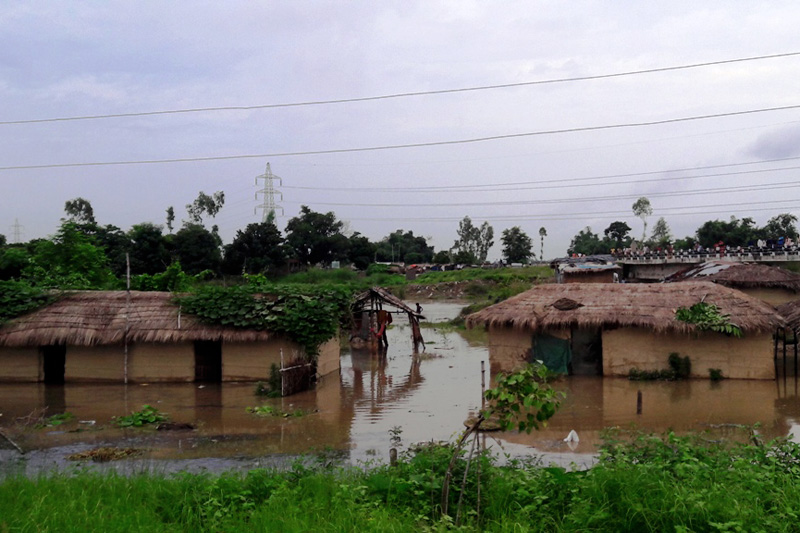Opinion: When floods strike, it’s the poor who suffer
The 2017 and 2019 monsoon floods in Nepal dilapidated many settlements, especially in the southern part of the country and across the riverbanks in the middle and high mountains. The 1993 and 2008 floods had already provided some lessons that should not have been forgotten to downscale the loss of lives and property. The notorious floods of 2017 and 2019 were in many aspects the same as those of 1993 and 2008. The key question here is whether Nepal is learning from the destruction and losses and acting proactively to counteract the multi-faceted challenges of floods.
Traditionally, floods used to be dealt in isolation - just as a hydrologic and hydraulic phenomenon with little to sparse influence on other dimensions. Since the challenge is multi-faceted, multi-disciplinary approaches are a must to deal with it. To this end, our research group recently conducted an interdisciplinary research on flood hazard mapping and flood vulnerability analysis of wattle and daub houses that are dominant across the river banks in the southern parts of the country and are mostly constructed by the people dwelling in informal to slum and squatter settlements.
The paper entitled ‘Catchment-scale flood hazard mapping and flood vulnerability analysis of residential buildings: The case of Khando River in eastern Nepal’, published in the prestigious Journal of Hydrology: Regional Studies, summarises that the conventional understanding of flood damage to residential buildings is too conservative and needs a serious revision.
Unlike reinforced concrete and brick or stone houses, which are more robust than wattle and daub houses, floods can easily sweep away such houses leaving no impression of a settlement behind. We considered the notorious Khando River that passes through Saptari district in eastern Nepal to assess the impact of flooding and estimate the flood itself at various time intervals.
Due to grave sediment transport and channel shifting, the flooding pattern in most non-perennial rivers, such as the Khando, should be treated rather probabilistically. Over the decades, meandering river and channel shifting have made thousands of people homeless and caused enormous losses. The analysis outlined that even for a low return interval, the flooding would be really high. This may have feeble impact in areas without settlements and farms, but when the flood takes its course via settlements, then most of the wattle and daub houses will suffer beyond repair.
Due to lack of adequate foundation and superstructure strength, even an inundation of 0.1 meter may initiate damage to wattle and daub construction. Meanwhile, if the inundation is 1 metre in depth, most of the houses that belong to economically deprived people would lose regular functionality. However, no efforts have been made to improve the conventional low-cost housing system to morph as a cost-effective housing solution that could sustain at least moderate floods.
The scene is tumultuous as no governing mechanism and capacity building have penetrated most of such settlements, and housing construction lacks any form of technicality. Thus, they just dip the bamboo for around a foot. That would be easily ejected by the eroding flood.
Nepal is categorised as the 30th most hazard-prone country in terms of flood hazards by the United Nations Development Programme, and the intertwining impacts of climate change related phenomenon together with the vulnerable settlements may lead to losses beyond imagination if immediate actions are not deployed.
From awareness to easy access to information related to flood occurrence, efforts could shift the paradigm effectively by lowering the damage and slicing the impacts of the losses. The first effort that could be instrumental is capacity building in informal and slum and squatter settlements by hands-on trainings for improved construction. Thereafter, some tech-savvy simulations and models could be developed to optimise the construction system.
Furthermore, river channel management and protection work may play a vital role in protecting communities but may be uneconomic as Nepal has a number of such notorious rivers and greater number of economically deprived communities across the river banks.
Flood hazard mapping and map-based settlement planning and development may also provide a rational basis for resettlement of vulnerable communities; however, river channel shifting is quite frequent and may alter the hazard maps. So, river management and development of flood resilient construction systems may be a wiser solution.
The vicious impacts of flooding range from visible damage to societal challenges. And, housing is undoubtedly the most important aspect of human life to stay safe despite the natural challenges. Lessons of historical and recent floods are valuable assets together with the scientific research findings as they germinate avant garde solutions for effectively managing flood hazards and its multi-faceted challenges.
The cyclic phenomenon of reconstructing the same houses every year will not alter the paradigm, rather pragmatic solutions based on thorough understanding of the benign steps is a must. Unlike most of the natural hazards, floods are better managed if checked on time. Flood disasters are well-known in Nepal but saving lives and property is unheard of. The status quo in construction systems and state-of-the art knowledge seemingly forget the impacts and countermeasures of flooding, especially in buildings. The resolution right before the monsoon of 2020 should be to protect the lives and property in informal and slum and squatter settlements as when floods strike, the perils of the poor multiply.
Gautam is researcher in multi-hazards impacts on structures and infrastructure






